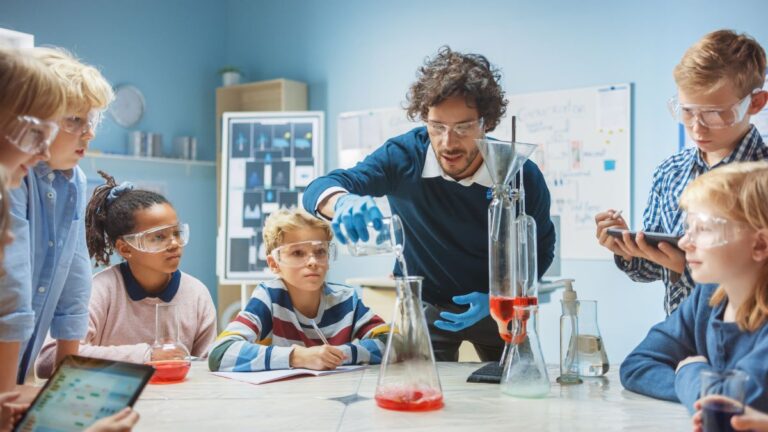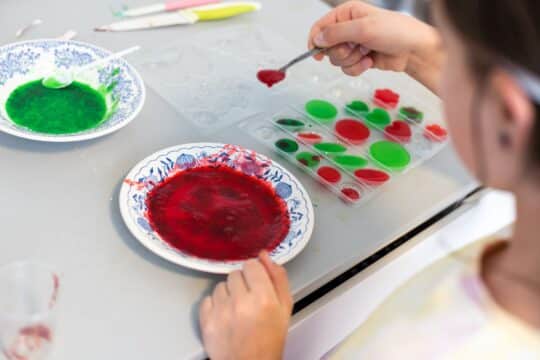Engaging 5th graders in hands-on experiments is a great way to pique your students’ curiosity and foster a deeper understanding of scientific concepts. Here is a series of fun and educational science experiments designed specifically for 5th graders.
Experiment 1: Volcano Eruption
Volcano Eruption demonstrates a fun and visually exciting chemical reaction between baking soda and vinegar, simulating a volcanic eruption with bubbling “lava.”
Materials Needed
- Baking soda
- Vinegar
- Red food coloring
- Dish soap
- A small plastic bottle
- Modeling clay or papier-mâché (optional)
- A tray or large dish
Instructions
- Create your volcano by molding modeling clay or papier-mâché around the plastic bottle, leaving the bottle’s opening uncovered. (This is optional. The experiment still works without this step)
- Place the volcano on a tray to catch any overflow.
- Add a couple of tablespoons of baking soda to the bottle.
- Pour a small amount of dish soap into the bottle.
- Add a few drops of red food coloring to give the lava its fiery color.
- Pour vinegar into the bottle and watch the volcano erupt!
How did that work?
The eruption is a chemical reaction between baking soda (a base) and vinegar (an acid), which creates a chemical reaction that releases carbon dioxide gas, making the mixture bubble up and overflow like lava!
Experiment 2: Balloon Rocket
Balloon Rocket demonstrates Newton’s third law of motion by using escaping air from a balloon to create thrust, propelling it along a string.
Materials Needed
- Long balloons
- String
- Straws
- Tape
- Two chairs
Instructions
- Tie one end of the string to the back of a chair.
- Thread a straw onto the string, then tie the other end of the string to another chair.
- Inflate a balloon without tying the end and tape it to the straw.
- Pull the straw to one end of the string.
- Let go of the balloon and watch it race along the string.
How did that work?
As the air escapes from the balloon, it creates a thrust that propels the balloon forward along the string. This demonstrates Newton’s third law of motion: for every action, there is an equal and opposite reaction.
Experiment 3: Make a Rainbow
Make a Rainbow demonstrates how light refraction creates a spectrum of colors when it passes through water and reflects off a mirror.
Materials Needed
- Clear container with water
- Mirror
- Sheet of white paper
- Access to a sunlit window
Instructions
- Place the bowl in front of the window, then place the mirror partway into the water facing the light.
- Hold the paper to intersect the reflection and watch as the rainbow appears.
How did that work?
This experiment demonstrates when light is refracted. When light enters another substance of a different density, it causes the light to bend, and this shows up on paper as different bands of color.
Experiment 4: Walking Water
Walking Water demonstrates capillary action as colored water moves through paper towel fibers, transferring liquid from one cup to another.
Materials Needed
- Clear cups
- Water
- Different color food coloring
- White paper towels
Instructions
- Cut a paper towel in half.
- Fold one piece half lengthwise, and half lengthwise again, so you have a long strip of paper towel. Do this twice.
- Line three cups next to one another in a row. Fill the outer cups with water and a drop of food coloring and leave the inner one empty.
- Place one end of the paper towel strip in the cup with water, and the other end in the empty cup. Do the same with the other paper towel strip.
- Watch as the colored water “walks” from the outer cups to the middle cup. This is fascinating.
How did it work?
The water travels through gaps in the paper towel fibers and “walks” into the empty jar. This is a process called capillary action.
Experiment 5: Static Electricity
Static Electricity demonstrates how rubbing a balloon transfers electrons, creating a negative charge that attracts small paper pieces through static electricity.
Materials Needed
- Balloon
- Wool cloth or your hair
- Tissue paper or small paper pieces
Instructions
- Inflate the balloon and tie it closed.
- Rub the balloon vigorously on the wool cloth or your hair for about 30 seconds.
- Hold the balloon close to the tissue paper or small paper pieces and watch as they are attracted to the balloon.
How did it work?
Rubbing the balloon transfers electrons from the wool or hair to the balloon, giving it a negative charge. The negatively charged balloon attracts the positively charged paper pieces due to the static electricity created.
Experiment 6: Invisible Ink
Invisible Ink demonstrates how lemon juice oxidizes when heated, revealing a hidden message through a simple chemical change.
Materials Needed
- Lemon juice
- Water
- Cotton swabs or a small paintbrush
- White paper
- Iron or a lamp
Instructions
- Mix equal parts lemon juice and water in a small container.
- Use a cotton swab or paintbrush to write a message on the white paper using the lemon juice mixture.
- Allow the paper to dry completely.
- To reveal the hidden message, gently heat the paper using an iron set on low or by holding it close to a lamp.
How did it work?
Lemon juice is an organic substance that oxidizes and turns brown when heated. The heat causes the written message to become visible, illustrating the chemical changes that occur with heat.
Experiment 7: Will it Leak?
Will it Leak? Demonstrates how flexible polymers in plastic bags create a temporary seal around pencils, preventing water from leaking until the seal is broken.
Materials Needed
- Water
- Plastic storage bags
- Sharp pencils
Instructions
- Fill the bag with water and make sure there are no holes in the bag.
- Have one student hold the top of the bag tight, while another person sticks the pencils straight (not angled) through the bag.
- Challenge students to see how many pencils they can get through the bag before it breaks.
- Disclaimer – make sure you do it outdoors because you may get wet.
How did that work?
Plastic bags are made of a material called Polymers. Polymers are flexible, so when you stick a pencil through them, they push back on the pencil to form a seal. When you remove the pencils, the water leaks out because the Polymers are pushed aside.
These experiments are not only fun but also serve as an excellent introduction to scientific principles for 5th graders.
Each experiment demonstrates fundamental concepts such as chemical reactions, motion, density, and static electricity. By participating in these activities, young students can develop a passion for science and a curiosity about how the world works.
Educators never stop learning; check out our available graduate degree programs to hone your skills and promote lifelong learning and academic excellence.




